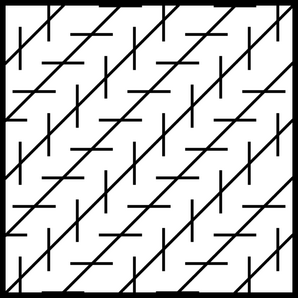
The Zöllner illusion is a classic optical illusion, named after its discoverer, German astrophysicist, Johann Karl Friedrich Zöllner.
In this figure the black lines seem to be unparallel, but in reality they are parallel. The shorter lines are on an angle to the longer lines. This angle helps to create the impression that one end of the longer lines is nearer to the viewer than the other end. This is very similar to the way the Wundt illusion appears. It may be that the Zöllner illusion is caused by this impression of depth.
If the illusion is printed in green on a red background and the red and green are equally bright, the illusion disappears.
History[]
In 1860, Zöllner sent his discovery in a letter to physicist and scholar Johann Christian Poggendorff, editor of Annalen der Physik und Chemie, who subsequently discovered the related Poggendorff illusion, in the original drawing (Table VIII Figure 4) of Zöllner.
This illusion is similar to the Hering illusion, the Poggendorff illusion and the Müller-Lyer illusion. All these illusions demonstrate how lines can seem to be distorted by their background.
External Links[]
- http://www.cut-the-knot.org/Curriculum/Geometry/Zollner.shtml
- http://mathworld.wolfram.com/ZoellnersIllusion.html
- https://webspace.utexas.edu/cokerwr/www/index.html/illusion65.html
- http://www.wyrmcorp.com/galleries/illusions/lines.shtml
- http://www.daviddarling.info/encyclopedia/Z/Zollner_illusion.html
- http://fineartamerica.com/featured/zoellner-illusion-spl-and-photo-researchers.html
